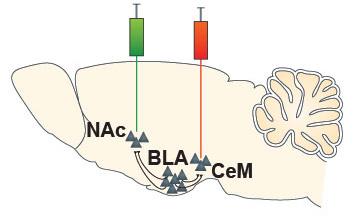Neuroscientists have discovered brain circuitry for encoding positive and negative learned associations in mice. After finding that two circuits showed opposite activity following fear and reward learning, the researchers proved that this divergent activity causes either avoidance or reward-driven behaviors.
Prior to the new study in Nature, scientists suspected involvement of the circuits ultimately implicated, but were stumped by a seeming paradox. A crossroads of convergent circuits in an emotion hub deep in the brain, the basolateral amygdala, seem to be involved in both fear and reward learning, but how one brain region could orchestrate such opposing behaviors - approach and avoidance - remained an enigma. How might signals find the appropriate path to follow at this fork in the road?
To find out, researchers explored whether two suspect circuit projections from the crossroads might hold clues. One projects to a reward center, the nucleus accumbens, and the other to a nearby fear center, the centromedial amygdala, the output station of the emotion hub.

The researchers pinpointed separate brain circuits for positive and negative associations in mouse brain by injecting retrograde fluorescent bead tracers (green, red) that migrated upstream through neuronal projections linking a reward center (NAc, nucleus accumbens) and a fear center (CeM, centromedial amygdala) to an emotional memory crossroads (BLA, basolateral amygdala). Credit: Praneeth Namburi, Anna Beyeler, Ph.D., Kay M. Tye, Ph.D., Massachusetts Institute of Technology
Each circuit projection is composed of separate populations of intertwined neurons. The researchers first used telltale fluorescent bead tracers to sort out which neurons belonged to each circuit. They then measured an indicator of connectivity - the strength of neural connections - in the projections, after mice underwent fear or reward learning. Animals were trained to either fear a tone paired with a shock or to associate the tone with a sugar reward.
Strikingly, crossroads connectivity to reward center projections decreased after fear learning and increased with reward learning. By contrast, connectivity to fear center projections increased with fear learning and decreased after reward learning.
These converging mechanisms in anatomically intertwined circuits could hold clues to teasing apart how positive and negative emotional associations may influence each other, Tye suggested.
To prove a causal link between the projection-identified circuits and behavior, Tye's team turned to optogenetics, which enables light pulses to control brain circuitry in animals genetically engineered to be light-responsive. Optically stimulating the reward center projection enhanced positive reinforcement, while stimulating the fear center projection promoted negative reinforcement. Similarly, blocking the fear center projection impaired fear learning and enhanced reward learning.
Finally, the researchers pinpointed defining electrophysiological, anatomic and genetic features of the two circuits that help to explain the opposite connectivity responses.




Comments